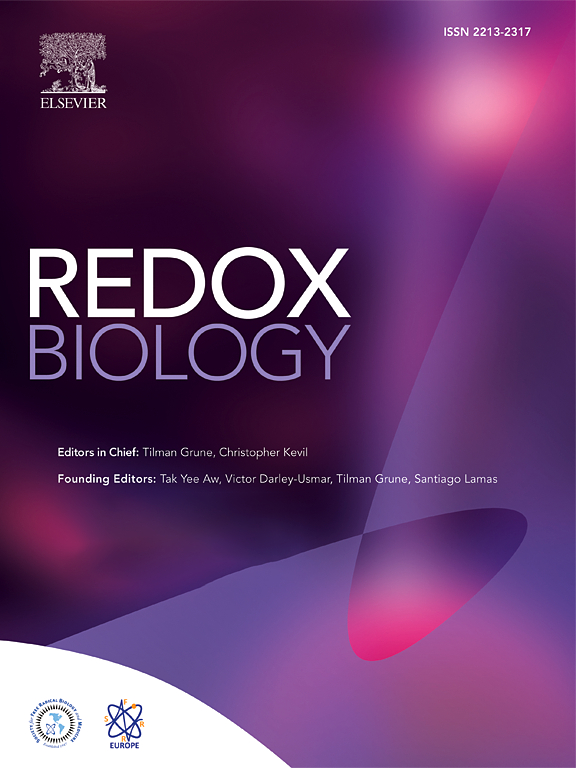Guardian of myelin and neural Integrity: foxo1a through slc7a11 mitigating oxidative damage in myelin
IF 10.7
1区 生物学
Q1 BIOCHEMISTRY & MOLECULAR BIOLOGY
引用次数: 0
Abstract
The emergence of myelin marks an evolutionary leap from jawless to jawed vertebrates. Although myelin's role in promoting rapid neural signal transmission and brain complexity is known, its neuroprotective mechanisms in complex signal transmission remain unclear. This study identifies the critical FoxO gene family member, foxo1a, as essential to the evolution of jawed vertebrates by comparing divergence times and gene family heterogeneity between jawless and jawed vertebrates. We found that foxo1a is located in zebrafish oligodendrocytes and myelin, playing a key antioxidant protective role. Specifically, we found that knocking out the foxo1a gene leads to abnormal myelin development in the central nervous system of zebrafish, a reduction in oligodendrocytes, astrocytes, and myelin markers, and induces freezing behavior. Further research revealed that this is related to oxidative stress responses and ferroptosis in the central nervous system of zebrafish following the deficiency of the foxo1a gene. Mechanistically, we discovered that foxo1a is involved in regulating oxidative stress responses and iron homeostasis in the central nervous system by directly regulating the promoter activity of the slc7a11 gene. In terms of application, we found that exogenous supplementation of foxo1a can exert antioxidant protective effects in a copper sulfate-induced myelin damage model. More importantly, we found a parallelism of the foxo1a-slc7a11 axis in both zebrafish and human cells, suggesting that the foxo1a-slc7a11 axis might be an evolutionarily conserved neural defense strategy in jawed vertebrates. In conclusion, our study elucidates the critical role of foxo1a in maintaining antioxidant homeostasis in the central nervous system and provides new insights into the adaptive evolution of the central nervous system in jawed vertebrates.
髓磷脂和神经完整性的守护者:foxo1a通过slc7a11减轻髓磷脂的氧化损伤
髓磷脂的出现标志着脊椎动物从无颌动物到有颌动物的进化飞跃。髓磷脂在促进神经信号快速传递和大脑复杂性中的作用是已知的,但其在复杂信号传递中的神经保护机制尚不清楚。本研究通过比较无颌和有颌脊椎动物之间的分化时间和基因家族异质性,确定了关键的FoxO基因家族成员foxo1a对有颌脊椎动物的进化至关重要。我们发现foxo1a位于斑马鱼少突胶质细胞和髓鞘中,起着关键的抗氧化保护作用。具体来说,我们发现敲除foxo1a基因会导致斑马鱼中枢神经系统髓磷脂发育异常,减少少突胶质细胞、星形胶质细胞和髓磷脂标记物,并诱导冻结行为。进一步的研究表明,这与斑马鱼foxo1a基因缺失后中枢神经系统的氧化应激反应和铁下垂有关。在机制上,我们发现foxo1a通过直接调节slc7a11基因的启动子活性参与调节中枢神经系统的氧化应激反应和铁稳态。在应用方面,我们发现外源性补充foxo1a可以在硫酸铜诱导的髓磷脂损伤模型中发挥抗氧化保护作用。更重要的是,我们在斑马鱼和人类细胞中发现了foxo1a-slc7a11轴的平行性,这表明foxo1a-slc7a11轴可能是颌脊椎动物进化上保守的神经防御策略。总之,我们的研究阐明了foxo1a在维持中枢神经系统抗氧化稳态中的关键作用,并为有颌脊椎动物中枢神经系统的适应性进化提供了新的见解。
本文章由计算机程序翻译,如有差异,请以英文原文为准。
求助全文
约1分钟内获得全文
求助全文
来源期刊

Redox Biology
BIOCHEMISTRY & MOLECULAR BIOLOGY-
CiteScore
19.90
自引率
3.50%
发文量
318
审稿时长
25 days
期刊介绍:
Redox Biology is the official journal of the Society for Redox Biology and Medicine and the Society for Free Radical Research-Europe. It is also affiliated with the International Society for Free Radical Research (SFRRI). This journal serves as a platform for publishing pioneering research, innovative methods, and comprehensive review articles in the field of redox biology, encompassing both health and disease.
Redox Biology welcomes various forms of contributions, including research articles (short or full communications), methods, mini-reviews, and commentaries. Through its diverse range of published content, Redox Biology aims to foster advancements and insights in the understanding of redox biology and its implications.
 求助内容:
求助内容: 应助结果提醒方式:
应助结果提醒方式:


